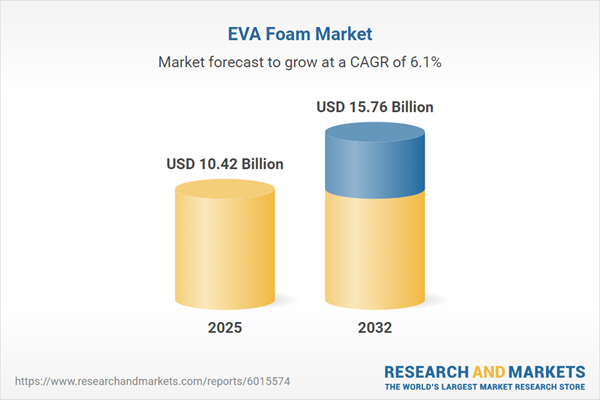Speak directly to the analyst to clarify any post sales queries you may have.
The EVA foam market is rapidly evolving as organizations prioritize adaptability, robust supply chain management, and sustainability to address changing industry demands. Senior decision-makers now recognize EVA foam as a strategic material choice, essential for staying competitive in dynamic procurement and operations environments.
Market Snapshot: Growth Dynamics of the EVA Foam Market
The global EVA foam market is marked by strong and sustained growth, backed by increasing demand across key sectors. Industries such as automotive, construction, medical, footwear, packaging, and sports equipment continue to drive this expansion. The integration of innovative technologies, especially in automation and process optimization, is boosting both quality and operational efficiency across production lines. Senior decision-makers are navigating a landscape shaped by shifting regulatory requirements and heightened competition, leveraging agile value chain strategies to meet diverse global and regional customer expectations.
Scope & Segmentation: Comprehensive Breakdown of the EVA Foam Market
- Application Areas: Automotive components utilize EVA foam for sealing solutions and enhanced safety. Construction projects employ it for insulation and weatherproofing. Consumer goods benefit from its versatility in furniture underlays and children’s products, while sports equipment manufacturers rely on its protective and durable properties. The medical sector adopts EVA foam for use in orthopedic and other specialized medical devices, and the packaging industry integrates it for superior cushioning and product protection.
- Type: Cross linked foams are chosen for longevity and structural integrity. Low resilience EVA foams provide optimal shock absorption in sensitive products. Open cell options deliver breathability and ergonomic comfort for demanding applications.
- Distribution Channel: Direct sales routes serve large-volume buyers and streamline procurement costs. Retail and wholesale outlets support smaller-scale buyers. Digital platforms give buyers agility and the ability to respond swiftly to urgent supply needs.
- Density Options: High density EVA foam fulfills structural and load-bearing roles. Medium density variants balance durability with comfort across multiple sectors. Low density foams are tailored for ergonomic applications demanding improved cushioning.
- Thickness Profiles: Thin EVA foam sheets cater to light-duty usage. Intermediate thicknesses are optimal for flexibility in diverse environments. Thicker variants meet the needs of industrial and protective applications.
- Regional Markets: Activity spans the Americas, Europe, Middle East & Africa, and Asia-Pacific. Regional markets bring unique strengths, from advanced manufacturing in Europe to cost-effective supply networks in Asia-Pacific, all of which shape procurement approaches and innovation priorities in the EVA foam industry.
Key Takeaways: Strategic Insights for Senior Decision-Makers
- Innovation in cross linking processes is enabling organizations to develop robust and highly tailored EVA foam solutions that address evolving end-user requirements.
- Sustainability continues to gain traction as firms accelerate adoption of recycled and bio-based EVA polymers to enhance responsible sourcing and supply chain resilience.
- Digital transformation throughout the EVA foam market is leading to shorter product development cycles, allowing companies to meet rapidly changing client needs and streamline market entry.
- Growth in sectors such as automotive, construction, and healthcare is driving interest in lightweight and ergonomic EVA foam applications, increasing market penetration in energy-efficient and comfort-driven product lines.
- Organizations deploying flexible, multi-channel procurement models are improving risk management capabilities and operational agility in the face of unpredictable market conditions and supply chain disruptions.
Tariff Impact: Market Shifts Triggered by United States Policies
United States tariffs introduced in 2025 on designated polymer grades have altered cost structures for EVA foam importers and processors. In response, businesses are expanding their supplier networks, investing in internal compounding, and refining logistics strategies to maintain cost control and uphold product quality. This shift is influencing procurement and R&D collaboration, which has become critical in sectors such as packaging and footwear where consistent material performance is vital.
Methodology & Data Sources
This market analysis draws on expert interviews, industry journals, and detailed company reporting. Data triangulation and advanced market modeling underpin the reliability of segment relationships, and peer review by subject matter experts safeguards analytical accuracy for senior decision-makers.
Why This Report Matters
- Offers clear segmentation and actionable guidance to support procurement teams, product developers, and operational leaders making market-facing decisions in the EVA foam market.
- Provides frameworks for managing regulatory change, responding to tariff impacts, and advancing towards more sustainable EVA foam solutions.
- Enables benchmarking of supply chain practices and technology investments for proactive risk management and maintaining strategic industry positioning.
Conclusion
Organizations investing in innovative materials, sustainability, and supply chain optimization will continue to strengthen their market positions. With strategic focus, senior leaders in the EVA foam industry can confidently navigate sector changes and future-proof their operations.
Additional Product Information:
- Purchase of this report includes 1 year online access with quarterly updates.
- This report can be updated on request. Please contact our Customer Experience team using the Ask a Question widget on our website.
Table of Contents
3. Executive Summary
4. Market Overview
7. Cumulative Impact of Artificial Intelligence 2025
Companies Mentioned
The companies profiled in this EVA Foam market report include:- Dow Inc.
- BASF SE
- China Petroleum & Chemical Corporation
- LG Chem Ltd.
- Kaneka Corporation
- Mitsui Chemicals, Inc.
- Sumitomo Chemical Co., Ltd.
- DIC Corporation
- Sekisui Plastics Co., Ltd.
- Huntsman International LLC
Table Information
| Report Attribute | Details |
|---|---|
| No. of Pages | 188 |
| Published | November 2025 |
| Forecast Period | 2025 - 2032 |
| Estimated Market Value ( USD | $ 10.42 Billion |
| Forecasted Market Value ( USD | $ 15.76 Billion |
| Compound Annual Growth Rate | 6.0% |
| Regions Covered | Global |
| No. of Companies Mentioned | 11 |









